If you’re the owner of an older Trane XE800 air conditioning unit, you may be wondering about its cooling capacity. Determining your system’s tonnage is crucial for proper maintenance, repairs, or when considering replacement options. This comprehensive 1000-word guide will walk you through all the methods to accurately determine your Trane XE800’s tonnage.
Before we dive into identifying your specific unit’s capacity, let’s first understand what “tonnage” means in HVAC terms. Contrary to what the name might suggest, an air conditioner’s tonnage doesn’t refer to its weight. Instead, it’s a measurement of cooling capacity where:
- 1 ton = 12,000 BTU/hour (British Thermal Units per hour)
- This measurement originates from the amount of heat needed to melt one ton of ice in 24 hours
The tonnage of your Trane XE800 directly affects:
- The cooling power of your system
- Energy efficiency
- Proper sizing for your home’s square footage
- Compatibility with replacement components
Locating Your Trane XE800’s Model Number
The most accurate way to determine your Trane tonnage is through the model number. On Trane XE800 units, you’ll find this information on the manufacturer’s data plate.
Where to Find the Data Plate
- Outdoor Condenser Unit:
- Check the rear or side panels
- Look near the refrigerant line connections
- May be located under the top grille
- Indoor Air Handler/Furnace:
- If the outdoor label is unreadable
- Typically on the front or side panel
Trane model numbers follow a specific pattern that reveals the unit’s capacity. For the XE800 series, you’ll typically see a format like:
TWE024C100A0 or TTP036D200B1
The critical digits for determining tonnage are the three numbers immediately following the letters (024 or 036 in these examples). These numbers represent the unit’s BTU rating in thousands.
Decoding the Trane XE800 Tonnage from Model Numbers
Here’s how to convert those numbers to tons:
- Take the first three digits after the letters (e.g., 024 or 036)
- Divide by 12 (since 12,000 BTU = 1 ton)
Common XE800 Model Numbers and Their Tonnage:
| Model Number Segment | BTU Rating | Tonnage Calculation | Actual Tonnage |
|---|---|---|---|
| TWE018… | 18,000 BTU | 18 ÷ 12 = 1.5 | 1.5 tons |
| TWE024… | 24,000 BTU | 24 ÷ 12 = 2 | 2 tons |
| TWE030… | 30,000 BTU | 30 ÷ 12 = 2.5 | 2.5 tons |
| TWE036… | 36,000 BTU | 36 ÷ 12 = 3 | 3 tons |
| TWE042… | 42,000 BTU | 42 ÷ 12 = 3.5 | 3.5 tons |
| TWE048… | 48,000 BTU | 48 ÷ 12 = 4 | 4 tons |
Alternative Methods to Determine the Trane XE800 Tonnage
If the model number is unreadable or missing, try these alternative approaches:
1. Measuring Physical Dimensions
While not as precise as the model number, the physical size of your outdoor unit can provide a rough estimate:
- 1.5-2 ton units: Typically 30-34 inches wide
- 2.5-3 ton units: Usually 34-38 inches wide
- 3.5-4 ton units: Often 38-42 inches wide
Note: This method provides only an approximation and shouldn't be relied upon for exact measurements.
2. Checking the Air Handler
The indoor unit often has matching capacity information:
- Locate the air handler or furnace
- Find its model number plate
- Look for similar numbering patterns (e.g., 024, 036)
3. Reviewing Installation Documents
Check for:
- Original purchase receipts
- Installation paperwork
- Maintenance records
- Warranty documents
These often list the unit’s specifications, including tonnage.
4. Calculating Based on Home Size
While not specific to your unit, you can estimate required tonnage by your home’s square footage:
- 1 ton per 400-600 sq ft (depending on climate and insulation)
- Example: 1,800 sq ft home would typically need 3 tons
Important: This method helps verify if your current unit is properly sized but doesn't confirm its actual capacity.
Understanding your Trane XE800’s capacity is important for several reasons:
- Replacement Parts Compatibility
- Ensures proper sizing of components like capacitors and contactors
- Helps when replacing the compressor or fan motor
- System Performance
- Oversized units short cycle, reducing efficiency
- Undersized units struggle to cool properly
- Energy Efficiency
- Properly matched systems operate more efficiently
- Helps calculate potential savings from upgrades
- Future Replacement Planning
- Ensures you replace with correctly sized equipment
- Helps when getting quotes from HVAC contractors
Common Issues With Older Trane XE800 Units
While determining your unit’s tonnage, you might encounter these common challenges:
- Faded or Missing Data Plates
- Common after 15-20 years of outdoor exposure
- Solution: Check indoor unit or installation records
- Previous Modifications
- Components may have been replaced with non-matching parts
- Solution: Consult an HVAC professional for assessment
- Multiple Systems in Larger Homes
- Homes may have multiple units of different capacities
- Solution: Check each unit separately
Consider professional help if:
- You can’t locate or read the model number
- The system has been modified
- You’re planning a replacement
- The unit isn’t cooling properly
A technician can:
- Measure refrigerant pressures to estimate capacity
- Check electrical specifications
- Assess overall system health
The Lifespan of a Trane XE800
While determining your unit’s tonnage, it’s worth noting:
- Typical lifespan: 15-20 years
- Efficiency declines after 10-12 years
- Older units may use R-22 refrigerant (no longer produced)
If your XE800 is approaching or exceeding 15 years, consider:
- Energy efficiency upgrades
- Replacement cost analysis
- Current system performance evaluation
Upgrading From a Trane XE800
If you’re considering replacement:
- Modern systems are significantly more efficient
- New units may qualify for rebates or tax credits
- Proper sizing is crucial for new installations
A professional load calculation (Manual J) will determine:
- Exact cooling needs for your home
- Proper sizing for replacement equipment
- Potential energy savings
Use this guide to help decide if upgrading from the Trane XE800 is right for you.
Finding your Trane XE800’s tonnage is relatively straightforward when you know where to look. Start with the model number on the outdoor unit’s data plate, using the three-digit code to calculate capacity. If that’s not available, alternative methods like checking the indoor unit, physical measurements, or installation documents can help.
Remember that while the XE800 was a reliable unit in its time, technology has advanced significantly. If your system is older than 15 years, it may be worth considering an upgrade for improved efficiency and performance.
Need help identifying the tonnage of your Trane XE800? Send me the numbers, and I’ll decode them for you.






